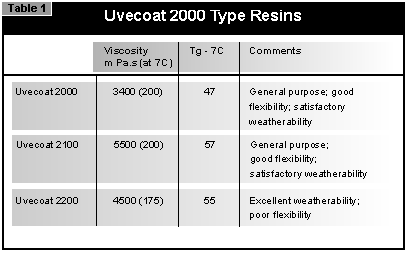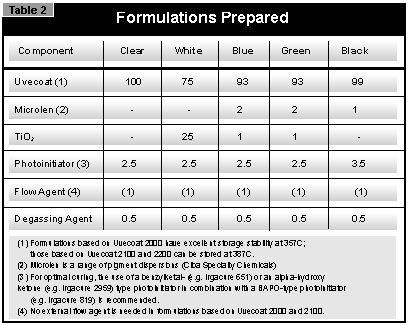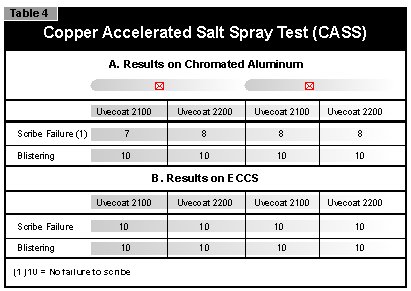
Preparation, handling and spraying procedures for a UV-curable powder formulation are similar to those for a thermosetting powder formulation. But in UV-curable powder coatings, melting/flow-out and curing are two separate processes. Upon exposure to heat, UV-curable powder coatings melt and flow into a smooth film. Cross-linking occurs when the molten film is exposed to UV light.
Absence of thermal cure during melting of UV-curable powder coatings allows optimum flow-out, resulting in smooth finishes even at relatively low temperatures (90 to 140°C). This low-temperature flow-out, combined with rapid curing, makes UV-curable powder coating an ideal method for coating several types of heat-sensitive substrates.
UCB
has developed a number of UV-curable powder systems in its research
laboratories. These systems illustrate potential applications for various
substrates. Formulations based on Uvecoat 1000 resins are especially suitable
for the coating of wood composites, such as medium-density fiberboard. The
Uvecoat 2000 resins are designed for use on metal surfaces and are available in
several types (Table 1).

UV-curable powders are also advantageous in the coating and curing of large-mass parts. With convection heating, long oven times are necessary to achieve a high enough temperature to fully cure the coating. Infrared heating has decreased the time for coating and curing large-mass parts. UV-curable powder coatings can further reduce curing time and increase energy savings.
Preassembled components may contain subassemblies made from various substrates, including some that are heat sensitive. An example of this is an object containing both metal and plastic parts, such as a motor containing electric wiring. In the past, subcomponents had to be individually painted and assembled so the heat-sensitive components would not be subjected to the heat needed to cure metal parts. The use of UV-curable powders allows the manufacturer to fully assemble a component and then apply a coating without damaging any heat-sensitive subassemblies. Because temperature require-ments are lower, the coating of heat-sensitive alloys also becomes possible with this new technology. The fast heating and curing cycle increases productivity for technologies, including the coating of blanks.
Irradiation of the molten film with UV light cross-links the UV-curable powder coatings. This activates the photoinitiator(s), causing the molten Uvecoat-based formulations described in this paper to react and form a network by a free-radical polymerization mechanism. Uvecoat 2000 resins used as binder in the studied formulations are polyesters containing (meth) acrylic double bonds. This type of cross-linking chemistry is also used in traditional liquid UV-curable coating technology. The main characteristics of the tested resins are listed in Table 1.
The
formulations used in this study are listed in Table 2. They were prepared
using conventional powder production methods on a twin-screw extruder. They were
applied electrostatically to yellow (Cr + 6) chromated aluminum and electrolytic
chromium-coated steel (ECCS) test panels. Clearcoats were applied at 50 to 90
microns (2 to 3.6 mils), and pigmented coatings were applied at 50 to 70 microns
(2 to 2.8 mils).

- IR zone settings: 100%, 100%, 100% 100%. Time: 15 sec.
- Combi-zone settings: 40%, 30%, 20%. Time: 40 sec.
- Convection-zone setting: 110ºC. Time: 60 sec.
Differential photocalorimetry measurements have shown 110°C is the optimum temperature for cross-linking.
The molten film is subsequently exposed to UV light. For clear formulations, both surface and in-depth cure are achieved by irradiating with two mercury vapour lamps (160 W/cm) at a line speed of 3 m/min (9.8 fpm). This corresponds with a UV dose of ±2000 mJ/cm~ (UV-A). For pigmented formulations, best results are obtained by irradiating with, successively, a Gallium-doped mercury vapour lamp (160 W/cm) and a mercury vapor lamp (160 W/cm), also at a line speed of 3 m/min; this corresponds with a UV dose of ±4000 mJ/cm~ (UV-V).
UV-curable powder coatings based on Uvecoat 2000 resins exhibit a high-gloss (60 degrees > 90). Depending on the heating cycle used, smooth to very smooth finishes can be achieved.
Adhesion was evaluated by doing a cross-cut test in accordance with ISO 2409. When taking into account the recommended coating thickness, clearcoats and pigmented systems exhibit a good to very good adhesion.
Flexibility
of the three systems was tested in a clear, white and black formulation on the
substrates previously mentioned. Flexibility was evaluated by doing an impact
and T-bending resistance test (falling ball test method according to ASTM D2794
for impact resistance and T-bending according to ASTM D4145). Tests are
performed at a temperature of 22 ±2°C after a one-hour relaxation period.
Impact resistance is tested after aging one week. Flexibility of Uvecoat 2000-
and 2100-based formulations is comparable on different types of substrates (Table
3). Impact resistance of formulations containing Uvecoat 2200 as the binder
is very low, except for clears where there is some degree of flexibility.

Corrosion
resistance was tested on the clear and white formulation using a copper
accelerated salt spray test according to ASTM B368. This test used a 5% salt
solution containing CuII chloride and glacial acetic acid; exposure time was 240
hours. In Table 4, both scribe failure (delamination next to the scribe)
and formulation of blisters are rated. All UV-curable powder systems tested
exhibit good corrosion resistance on chromated aluminum and electrolytic
chromium-coated steel.
Weathering Resistance
UCB has considerable experience in testing outdoor durable thermosetting powder coatings. The QUV-A test is a valuable accelerated-weathering method to forecast the durability of new polyester resins. UV-A bulbs provide a close reproduction of the solar spectrum to around 350 nm, which correlates to natural exposure in Florida.Using this accelerated-weathering test, the different Uvecoat systems were tested in a white RAL 9010 formulation and compared with a standard outdoor durable TGIC-based system. The cycle used is in accordance with ASTM G53-88. Panels were subjected to the alternate effects of condensation (4 hours at 50°C) and the damaging effects of sunlight simulated by the fluorescent UVA lamps (340 nm/I = 0.77 W/m2/nm) (8 hours at 60°C).
Gloss was measured at a 60-degree angle as a function of exposure time. The results show that the Uvecoat 2000-based formulation (Uvecoat 2100-based system performs in a comparable way) performs less well than the standard, but that the formulation based on Uvecoat 2200 performs extremely well.
The TGIC control showed a 50% reduction in gloss after about 3,100 hours of exposure, while the Uvecoat 2000/2100 system shows the same loss of gloss at about 1,800 hours. For the Uvecoat 2200 system, gloss is still higher than 75% of the original value after 6,000 hours.
In 1998, some pigmented formulations based on Uvecoat 2200 were sent to Florida for natural exposure (45-degree angle facing south). Blue, green and white formulations are shown in Table 2, and the percent of original gloss is compared with a white standard durable thermosetting powder system. After 18 months of exposure, all Uvecoat 2200-based systems exhibit a relative gloss of more than 95% and color difference (DE) is lower than 2. At the same time, the relative gloss of the standard had decreased to about 75%.
Based on these preliminary results, UCB states that UV-curable powder coatings based on Uvecoat 2200 have excellent weathering resistance and are well suited for outdoor applications.



